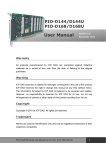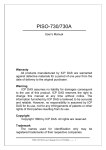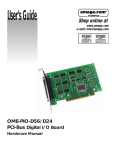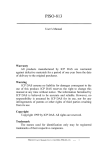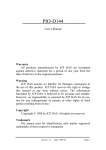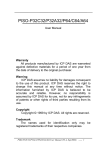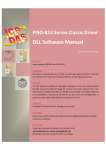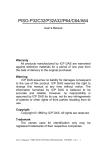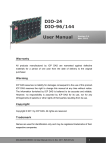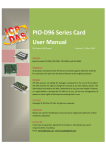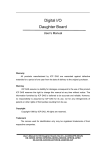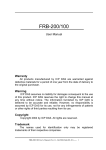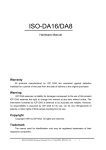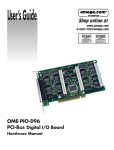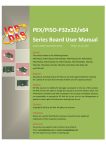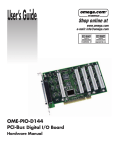Download 1. Introducton
Transcript
PIO-D56/D24
User Manual
Warranty
All products manufactured by ICP DAS are warranted
against defective materials for a period of one year from the
date of delivery to the original purchaser.
Warning
ICP DAS assume no liability for damages consequent to
the use of this product. ICP DAS reserves the right to change
this manual at any time without notice. The information
furnished by ICP DAS is believed to be accurate and reliable.
However, no responsibility is assumed by ICP DAS for its use,
nor for any infringements of patents or other rights of third
parties resulting from its use.
Copyright
Copyright 1999 by ICP DAS. All rights are reserved.
Trademark
The names used for identification only maybe registered
trademarks of their respective companies.
PIO-D56/PIO-D24 User Manual (Ver.1.0, 09/20/99) ---- 1
Tables of Content
1.
INTRODUCTION ................................................................................................................ 3
1.1
FEATURES ...................................................................................................................... 3
1.2
SPECIFICATIONS ............................................................................................................. 4
1.3
ORDER DESCRIPTION ...................................................................................................... 4
1.4 PCI DATA ACQUISITION FAMILY ....................................................................................... 5
1.5
2.
3.
PRODUCT CHECK LIST .................................................................................................... 5
HARDWARE CONFIGURATION ....................................................................................... 6
2.1
BOARD LAYOUT .............................................................................................................. 6
2.2
I/O PORT LOCATION ........................................................................................................ 7
2.3
ENABLE I/O OPERATION .................................................................................................. 7
2.4
INTERRUPT OPERATION ................................................................................................. 11
2.5
DAUGHTER BOARDS...................................................................................................... 18
2.6
PIN ASSIGNMENT .......................................................................................................... 24
I/O CONTROL REGISTER ............................................................................................... 26
3.1
HOW TO FIND THE I/O ADDRESS .................................................................................... 26
3.2 THE ASSIGNMENT OF I/O ADDRESS ................................................................................ 31
3.3
4.
THE I/O ADDRESS MAP ................................................................................................. 32
DEMO PROGRAM ........................................................................................................... 37
4.1
PIO_PISO ................................................................................................................... 38
4.2
DEMO1 ....................................................................................................................... 40
4.3
DEMO2 ....................................................................................................................... 41
4.4
DEMO3 ....................................................................................................................... 42
4.5
DEMO4 ....................................................................................................................... 44
4.6
DEMO5 ....................................................................................................................... 46
PIO-D56/PIO-D24 User Manual (Ver.1.0, 09/20/99) ---- 2
1.
Introduction
The PIO-D56/PIO-D24 provides 56/24 TTL digital I/O lines. The PIOD56/PIO-D24 consists of one 24-bit bi-directional port, one 16 bit input port and one
16 bit output port (only for PIO-D56). The 24-bit port supports three 8-bit groups PA,
PB & PC. Each 8-bit group can be configured to function as either inputs or outputs
individual. All groups at 24-bit bi-directional port are configured as inputs upon
power-up or reset.
The user can use the DB-24PD to connect the input port for isolation purpose,
or use DB-24RD to interface to the output port for relay control. The PIO-D56/PIOD24 has one D-sub connector and two 20-pin flat cable (only for PIO-D56). The flat
cable can be connected to ADP-20/PCI adapter. The adapter can be fixed on the
chassis. It can be installed in a 5V PCI bus and can support truly “Plug & Play”.
1.1
•
•
•
•
•
•
•
•
•
•
•
•
Features
PCI bus
Up to 56/24(PIO-D56/PIO-D24) channels of digital I/O
All I/O lines buffered on the board
Eight-bit groups independently selectable for I/O on 24-bit port
Input / Output programmable I/O ports under software control
Double side SMD, short card.
Connects directly to DB-24PR, DB-24PD, DB-24RD,
DB-24PRD, DB-16P8R, DB-24POR, DB-24SSR, DB-24C or any OPTO-22
Compatible daughter boards
4 interrupt sources: PC0,PC1,PC2,PC3
One DB37 connector, two 20-pin flat cable connectors(only for PIO-D56)
High driving capability
Automatically detected by windows 95/98/NT
No base address or IRQ switches to set
PIO-D56/PIO-D24 User Manual (Ver.1.0,09/20/99) ---- 3
1.2
Specifications
•
All inputs are TTL compatible
•
Logic high voltage : 2.4V (Min.)
Logic low voltage : 0.8V (Max.)
All outputs are TTL compatible
OPTO-22 output (CON3)
Sink current : 64mA (Max.)
Source current : 32mA(Max.)
•
•
•
16-channel output (CON1)
Sink current : 8mA (Max.)
Source current : 0.4mA(Max.)
Environmental :
Operating Temperature: 0°C to 60°C
Storage Temperature: -20°C to 80°C
Humidity: 0 to 90% non-condensing
Dimension: 143mm X 105mm
Power Consumption: +5V @ 530mA/420mA(PIO-D56/PIO-D24)
1.3
•
•
PIO-D56 : PCI bus 56-bit DI/O board
PIO-D24 : PCI bus 24-bit DI/O board
1.3.1
•
•
•
•
•
•
•
•
•
•
•
Order Description
Options
DB-24PD : 24 channel isolated D/I board
DB-24RD : 24 channels relay board
DB-24PRD : 24 channels power relay board
DB-16P8R : 16 channels isolated D/I and 8 channels relay output board
DB-24POR : 24 channels PhotoMos output board
DB-24C : 24 channels open-collector output board
ADP-20/PCI : extender, 20-pin header to 20-pin header for PCI bus I/O boards
NAPPCI/win : DLLs for Windows 95/98
NAPPCI/wnt : DLLs for Windows NT 4.0
NAPVIEW/1 : LabVIEW driver for Windows 95/98
NAPVIEW/2 : LabVIEW driver for Windows NT
PIO-D56/PIO-D24 User Manual (Ver.1.0, 09/20/99) ---- 4
1.4
PCI Data Acquisition Family
We provide a family of PCI-BUS data acquisition cards. These cards can be
divided into three groups as follows:
1. PCI-series: first generation, isolated or non-isolated cards
PCI-1002/1202/1800/1802/1602: multi-function family, non-isolated
PCI-P16R16/P16C16/P16POR16/P8R8: D/I/O family, isolated
PCI-TMC12: timer/counter card, non-isolated
2. PIO-series: cost-effective generation, non-isolated cards
PIO-823/821: multi-function family
PIO-D144/D96/D64/D56/D48/D24: D/I/O family
PIO-DA16/DA8/DA4: D/A family
3. PISO-series: cost-effective generation, isolated cards
PISO-813: A/D card
PISO-P32C32/P64/C64: D/I/O family
PISO-P8R8/P8SSR8AC/P8SSR8DC: D/I/O family
PISO-730: D/I/O card
PISO-DA2: D/A card
1.5
Product Check List
In addition to this manual, the package includes the following items:
• one piece of PIO-D56(or PIO-D24) card
• one piece of company floppy diskette or CD
• one piece of release note
It is recommended to read the release note firstly. All important information will be
given in release note as follows :
1. where you can find the software driver & utility
2. how to install software & utility
3. where is the diagnostic program
4. FAQ
Attention !
If any one of these items is missing or damaged, contact the
dealer from whom you purchased the product. Save the
shipping materials and carton in case you want to ship or store
the product in the future.
PIO-D56/PIO-D24 User Manual (Ver.1.0,09/20/99) ---- 5
2.
2.1
Hardware configuration
Board Layout
CON3
DI/O
Port0
Port1
Port2
PIO-D56
PIO-D24
PCI BUS
20
19
CON2
1
only for PIO-D56
D/I
2
19
CON1
20
1
D/O
2
PIO-D56/PIO-D24 User Manual (Ver.1.0, 09/20/99) ---- 6
2.2
I/O port Location
The PIO-D56/PIO-D24 consists of one 24-bit bi-directional port, one 16 bit input
port and one 16 bit output port (only for PIO-D56). The 24-bit port supports three 8bit groups PA, PB & PC. Each 8-bit group can be configured to function as either
inputs or outputs individual. All groups at 24-bit bi-directional port are configured as
inputs upon power-up or reset. The I/O port location is given as follows:
Connector of
PIO-D56/PIO-D24
PA0 ~ PA7
PB0 ~ PB7
PC0 ~ PC7
CON3 (DI/O)
Port0
Port1
Port2
Connector of PIO-D56
Description
CON1
D/O
CON2
D/I
Refer to Sec. 2.1 for board layout & I/O port location.
Note : PC0, PC1, PC2 and PC3 can be used as interrupt signal source. Refer to Sec.
2.4 for more information.
2.3
Enable I/O Operation
2.3.1
DI/O Port Architecture (CON3)
When the PC is power-up, all operation of D/I/O port (CON3) is disable. The
enable/disable of D/I/O port is controlled by the RESET\ signal. Refer to Sec. 3.3.1
for more information about RESET\ signal. The power-up states are given as follows :
• All D/I/O operations are disable
• All three D/I/O ports are configured as D/I port
• All D/O latch register are undefined.(refer to Sec. 2.3.2)
The user has to perform some initialization before using these D/I/O. The
recommended steps are given as follows:
Step 1: find address-mapping of PIO/PISO cards (refer to Sec. 3.1)
Step 2: enable all D/I/O operation (refer to Sec. 3.3.1)
Step 3: configure the three ports (in CON3) to their expected D/I/O state &
send the initial value to all D/O ports (refer to Sec. 3.3.8)
Refer to DEMO1.C for demo program.
PIO-D56/PIO-D24 User Manual (Ver.1.0,09/20/99) ---- 7
I/O select (Sec. 3.3.7)
RESET\ (Sec. 3.3.1)
disable\
D/I/O
Data
input
Latch
(Sec. 3.3.8)
Clock input
D/O latch CKT
disable
Data
Buffer
input
(Sec. 3.3.8)
Clock input
D/I buffer CKT
•
•
•
•
•
The RESET\ is in Low-state ! all D/I/O operation is disable
The RESET\ is in High-state ! all D/I/O operation is enable.
If D/I/O is configured as D/I port ! D/I= external input signal
If D/I/O is configured as D/O port ! D/I = read back of D/O
If D/I/O is configured as D/I port ! send to D/O will change the D/O latch
register only. The D/I & external input signal will not change.
PIO-D56/PIO-D24 User Manual (Ver.1.0, 09/20/99) ---- 8
2.3.2
DI Port Architecture (CON2)
When the PC is power-up, all operation of DI port (CON2) is disable. The
enable/disable of DI port is controlled by the RESET\ signal. Refer to Sec. 3.3.1 for
more information about RESET\ signal.
•
•
The RESET\ is in Low-state ! all DI operation is disable
The RESET\ is in High-state ! all DI operation is enable
RESET\
disable
Data
Buffer
input
CON2
Clock input
D/I buffer CKT
PIO-D56/PIO-D24 User Manual (Ver.1.0,09/20/99) ---- 9
2.3.3
DO Port Architecture (CON1)
When the PC is power-up, all operation of DO port (CON1) is disable. The
enable/disable of DO port is controlled by the RESET\ signal. Refer to Sec. 3.3.1 for
more information about RESET\ signal.
•
•
The RESET\ is in Low-state ! all DO operation is disable
The RESET\ is in High-state ! all DO operation is enable
The power-up states are given as follows:
• All DO operations are disable
• All output latch be cleared to Low-Level
RESET\
clear
Data
input
Latch
CON1
Clock input
D/O buffer CKT
PIO-D56/PIO-D24 User Manual (Ver.1.0, 09/20/99) ---- 10
2.4
Interrupt Operation
All PC0, PC1, PC2 and PC3 can be used as interrupt signal source. Refer to Sec.
2.1 for PC0/PC1/PC2/PC3 location. The interrupt of PIO-D56/PIO-D24 is leveltrigger & Active_High. The interrupt signal can be inverted or non-inverted
programmable. The procedures of programming are given as follows:
1. make sure the initial level is High or Low
2. if the initial state is High ! select the inverted signal (Sec. 3.3.6)
3. if the initial state is Low ! select the non-inverted signal (Sec. 3.3.6)
4. enable the INT function (Sec. 3.3.4)
5. If the interrupt signal is active ! program will transfer into the interrupt
service routine ! if INT signal is High now ! select the inverted input
! if INT signal is Low now ! select the non-inverted input
Refer to DEMO3.C & DEMO4.C for single interrupt source. Refer to
DEMO5.C for four interrupt sources.
If only one interrupt signal source is used, the interrupt service routine does not
have to identify the interrupt source. (refer to DEMO3.C & DEMO4.C)
If there are more than one interrupt source, the interrupt service routine has to
identify the active signals as follows : (refer to DEMO5.C)
1. Read the new status of the interrupt signal source
2. Compare the new status with the old status to identify the active signals
3. If PC0 is active, service PC0 & non-inverter/inverted the PC0 signal
4. If PC1 is active, service PC1 & non-inverted/inverted the PC1 signal
5. If PC2 is active, service PC2 & non-inverted/inverted the PC2 signal
6. If PC3 is active, service PC3 & non-inverted/inverted the PC3 signal
7. Save the new status to old status
Limitation: if the interrupt signal is too short, the new status may be as same as
old status. So the interrupt signal must be hold-active until the interrupt service
routine is executed. This hold time is different for different O.S. The hold time
can be as short as micro-second or as long as second. In general, 20ms is enough
for all O. S.
PIO-D56/PIO-D24 User Manual (Ver.1.0,09/20/99) ---- 11
2.4.1
Interrupt Block Diagram of PIO-D56/D24
INT_CHAN_0
INT_CHAN_1
INT\
Level_trigger
INT_CHAN_2
INT_CHAN_3
initial_low
active_high
The interrupt output signal of PIO-D56/PIO-D24, INT\, is Level_trigger &
Active_Low. If the INT\ generate a low-pulse, the PIO-D56/PIO-D24 will interrupt
the PC once a time. If the INT\ is fixed in low level, the PIO-D56/PIO-D24 will
interrupt the PC continuously. So that INT_CHAN_0/1/2/3 must be controlled in a
pulse type signals. They must be fixed in low level state normally and generated
a high_pulse to interrupt the PC.
The priority of INT_CHAN_0/1/2/3 is the same. If all these four signals are active
at the same time, then INT\ will be active only once a time. So the interrupt service
routine has to read the status of all interrupt channels for multi-channel interrupt.
Refer to Sec. 2.4 for mare information.
DEMO5.C → for multi-channel interrupt source
If only one interrupt source is used, the interrupt service routine doesn’t have to read
the status of interrupt source. The demo program, DEMO3.C & DEMO4.C are
designed for single-channel interrupt demo as follows:
DEMO3.C → for INT_CHAN_0 only (PC0 initial low)
DEMO4.C → for INT_CHAN_0 only (PC0 initial high)
PIO-D56/PIO-D24 User Manual (Ver.1.0, 09/20/99) ---- 12
2.4.2
INT_CHAN_0/1/2/3
INT_CHAN_0 (1/2/3)
PC0(PC1/PC2/PC3)
Inverted/Noninverted select
INV0(1/2/3)
Enable/Disable select
EN0(1/2/3)
The INT_CHAN_0 must be fixed in low level state normally and generated a
high_pulse to interrupt the PC.
The EN0 (EN1/EN2/EN3) can be used to enable/disable the INT_CHAN_0(1/2/3)
as follows : (Refer to Sec. 3.3.4)
EN0 (1/2/3) = 0 → INT_CHAN_0(1/2/3) = disable
EN0 (1/2/3) = 1 → INT_CHAN_0(1/2/3) = enable
The INV0 can be used to invert/non-invert the PC0 (1/2/3) as follows : (Refer to
Sec.3.3.6)
INV0 (1/2/3) = 0 → INT_CHAN_0(1/2/3) = inverted state of PC0 (1/2/3)
INV0 (1/2/3) = 1 → INT_CHAN_0(1/2/3) = non-inverted state of PC0 (1/2/3)
PIO-D56/PIO-D24 User Manual (Ver.1.0,09/20/99) ---- 13
2.4.3
Initial_high, active_low Interrupt source
If the PC0 is a initial_high, active_low signal, the interrupt service routine
should use INV0 to inverted/non-inverted the PC0 for high_pulse generation as
follows : ( Refer to DEMO4.C)
Initial set :
now_int_state=1;
/* initial state for PC0
*/
outportb(wBase+0x2a,0); /* select the inverted PC0 */
void interrupt irq_service()
{
if (now_int_state==1)
/* now PC0 is changed to LOW
*/(a)
{
/* --> INT_CHAN_0=!PC0=HIGH now
*/
COUNT_L++;
/* find a LOW_pulse (PC0)
*/
If((inport(wBase+7)&1)==0)/* the PC0 is still fixed in LOW
*/
{
/* ! need to generate a high_pulse
*/
outportb(wBase+0x2a,1);/* INV0 select the non-inverted input */(b)
/* INT_CHAN_0=PC0=LOW -->
*/
/* INT_CHAN_0 generate a high_pulse
*/
now_int_state=0;
/* now PC0=LOW
*/
}
else now_int_state=1;
/* now PC0=HIGH
*/
/* don’t have to generate high_pulse */
}
else
/* now PC0 is changed to HIGH
*/(c)
{
/* --> INT_CHAN_0=PC0=HIGH now
*/
COUNT_H++;
/* find a HIGH_pulse (PC0)
*/
If((inport(wBase+7)&1)==1)/* the PC0 is still fixed in HIGH
*/
{
/* need to generate a high_pulse
*/
outportb(wBase+0x2a,0);/* INV0 select the inverted input
*/(d)
/* INT_CHAN_0=!PC0=LOW -->
*/
/* INT_CHAN_0 generate a high_pulse
*/
now_int_state=1;
/* now PC0=HIGH
*/
}
else now_int_state=0;
/* now PC0=LOW
*/
/* don’t have to generate high_pulse */
}
if (wIrq>=8) outportb(A2_8259,0x20);
outportb(A1_8259,0x20);
}
(a)
(b)
(c)
PC0
INV0
INT_CHAN_0
PIO-D56/PIO-D24 User Manual (Ver.1.0, 09/20/99) ---- 14
(d)
2.4.4
Initial_low, active_high Interrupt source
If the PC0 is a initial_low, active_high signal, the interrupt service routine
should use INV0 to inverted/non-inverted the PC0 for high_pulse generation as
follows : ( Refer to DEMO3.C)
Initial set :
now_int_state=0;
/* initial state for PC0
*/
outportb(wBase+0x2a,1); /* select the non-inverted PC0 */
void interrupt irq_service()
{
if (now_int_state==1)
/* now PC0 is changed to LOW
*/(c)
{
/* --> INT_CHAN_0=!PC0=HIGH now
*/
COUNT_L++;
/* find a LOW_pulse (PC0)
*/
If((inport(wBase+7)&1)==0)/* the PC0 is still fixed in LOW
*/
{
/* ! need to generate a high_pulse
*/
outportb(wBase+0x2a,1);/* INV0 select the non-inverted input */(d)
/* INT_CHAN_0=PC0=LOW -->
*/
/* INT_CHAN_0 generate a high_pulse
*/
now_int_state=0;
/* now PC0=LOW
*/
}
else now_int_state=1;
/* now PC0=HIGH
*/
/* don’t have to generate high_pulse */
}
else
/* now PC0 is changed to HIGH
*/(a)
{
/* --> INT_CHAN_0=PC0=HIGH now
*/
COUNT_H++;
/* find a High_pulse (PC0)
*/
If((inport(wBase+7)&1)==1)/* the PC0 is still fixed in HIGH
*/
{
/* need to generate a high_pulse
*/
outportb(wBase+0x2a,0);/* INV0 select the inverted input
*/(b)
/* INT_CHAN_0=!PC0=LOW -->
*/
/* INT_CHAN_0 generate a high_pulse
*/
now_int_state=1;
/* now PC0=HIGH
*/
}
else now_int_state=0;
/* now PC0=LOW
*/
/* don’t have to generate high_pulse */
}
if (wIrq>=8) outportb(A2_8259,0x20);
outportb(A1_8259,0x20);
}
(a)
(b)
(c)
PC0
INV0
INT_CHAN_0
PIO-D56/PIO-D24 User Manual (Ver.1.0,09/20/99) ---- 15
(d)
2.4.5
Muliti Interrupt Source
Assume : PC0 is initial Low, active High,
PC1 is initial High, active Low
PC2 is initial Low, active High
PC3 is initial High, active Low
as follows :
PC0
PC1
PC2
PC3
PC0 & PC1 are
active at the same
time.
PC0 & PC1 are
return to normal
at the same time.
PC2 & PC3 are
active at the same
time.
PC2 & PC3 are
return to normal at
the same time.
Refer to DEMO5.C for source program. All these four falling-edge & rising-edge
can be detected by DEMO5.C.
Note: when the interrupt is active, the user program has to identify the active
signals. These signals maybe active at the same time. So the interrupt service
routine has to service all active signals at the same time.
PIO-D56/PIO-D24 User Manual (Ver.1.0, 09/20/99) ---- 16
void interrupt irq_service()
{
new_int_state=inportb(wBase+7)&0x0f;
int_c=new_int_state^now_int_state;
if ((int_c&0x1)!=0)
{
if ((new_int_state&0x01)!=0)
{
CNT_H1++;
}
else
{
CNT_L1++;
}
invert=invert^1;
}
if ((int_c&0x2)!=0)
{
if ((new_int_state&0x02)!=0)
{
CNT_H2++;
}
else
{
CNT_L2++;
{
invert=invert^2;
}
if ((int_c&0x4)!=0)
{
If ((new_int_state&0x04)!=0)
{
CNT_H3++;
}
else
{
CNT_L3++;
}
invert=invert^4;
}
/*
/*
/*
/*
read all interrupt state
compare which interrupt
signal be change
INT_CHAN_0 is active
*/
*/
*/
*/
/* now PC0 change to high
*/
/* now PC0 change to low
*/
/* to generate a high pulse
*/
/* now PC1 change to high
*/
/* now PC1 change to low
*/
/* to generate a high pulse
*/
/* now PC2 change to high
*/
/* now PC2 change to low
*/
/* to generate a high pulse
*/
if ((int_c&0x8)!=0)
{
if ((new_int_state&0x08)!=0) /* now PC3 change to high
{
CNT_H4++;
{
else
/* now PC3 change to low
{
CNT_L4++;
}
invert=invert^8;
/* to generate a high pulse
}
now_int_state=new_int_state;
outportb(wBase+0x2a,invert);
if (wIrq>=8) outportb(A2_8259,0x20);
outportb(A1_8259,0x20);
}
PIO-D56/PIO-D24 User Manual (Ver.1.0,09/20/99) ---- 17
*/
*/
*/
2.5
Daughter Boards
2.5.1
DB-37
The DB-37 is a general purpose daughter board for D-sub 37 pins. It is designed
for easy wire connection.
2.5.2
DN-37
The DN-37 is a general purpose daughter board for DB-37 with DIN-Rail
Mounting. It is designed for easy wire connection..
37pin cable
DN-37
2.5.3
DB-8125
The DB-8125 is a general purpose screw terminal board. It is designed for easy
wire connection. There are one DB-37 & two 20-pin flat-cable header in the DB-8125.
37pin cable
DB-8125
(for DB-37 or
20-pin flat-cable header)
PIO-D56/PIO-D24 User Manual (Ver.1.0, 09/20/99) ---- 18
2.5.4
ADP-20/PCI
The ADP-20/PCI is a extender for 20-pin header. One side of ADP-20/PCI
can be connected to a 20-pin header. The other side can be mounted on the PC chassis
as follows :
NOTE : The user can choose the suitable extender for his own application
PIO-D56/PIO-D24 User Manual (Ver.1.0,09/20/99) ---- 19
2.5.5
DB-24PD Isolated Input Board
The DB-24PD is a 24-channel isolated digital input daughter board. The
optically isolated inputs of the DB-24PD consist of a bi-directional optocoupler with a
resistor for current sensing. You can use the DB-24PD to sense DC signal from TTL
levels up to 24V or use the DB-24PD to sense a wide range of AC signals. You can
use this board to isolated the computer from large common-mode voltage, ground
loops and transient voltage spike that often occur in industrial environments.
V+
PIO-D56/D24
VOpto-Isolated
PIO-D56/D24
DB-24PD
AC or DC Signal
0V to 24V
DB-24PD
50-pin flat-cable header
Yes
D-sub 37-pin header
Yes
PIO-D56/PIO-D24 User Manual (Ver.1.0, 09/20/99) ---- 20
2.5.6
DB-24RD Relay Board
The DB-24RD, 24-channel relay output board, consists of 24 form C relays for
efficient switch of load by programmed control. The relay are energized by apply
12V/24V voltage signal to the appropriated relay channel on the 50-pin flat
connector. There are 24 enunciator LEDs for each relay, light when their associated
relay is activated.
Form C Relay
Normal Open
Normal Close
Com.
DB-24RD
PIO-D56/PIO-D24
Note:
Channel : 24 Form C Relay
Relay : Switching up to 0.5A at 110ACV
or 1A at 24DCV
DB-24RD
50-pin flat-cable header
Yes
D-sub 37-pin header
Yes
DB-24R, DB-24RD
24*Relay (120V, 0.5A)
DB-24PR,DB-24PRD
24* Power Relay (250V, 5A)
DB-24POR
24*photoMOS Relay (350V, 01.A)
DB-24SSR
24*SSR (250VAC, 4A)
DB-24C
24*O.C. (30V, 100 mA)
DB-16P8R
16*Relay (120V, 0.5A) + 8*isolated input
PIO-D56/PIO-D24 User Manual (Ver.1.0,09/20/99) ---- 21
2.5.7
DB-24PRD, DB-24POR, DB-24C
DB-24PRD
24*power relay, 5A/250V
DB-24POR
24*photoMOS relay, 0.1A/350VAC
DB-24C
24*open collector, 100mA per channel, 30V max.
The DB-24PRD, 24-channel power relay output board, consists of 8 form C and
16 form A electromechanical relays for efficient switching of load programmed
control. The contact of each relay can control a 5A load at 250ACV/30VDCV. The
relay is energized by applying a 5 voltage signal to the appropriate relay channel on
the 20-pin flat cable connector(just used 16 relays) or 50-pin flat cable
connector.(OPTO-22 compatible, for DIO-24 series). Twenty - four enunciator LEDs,
one for each relay, light when their associated relay is activated. To avoid overloading
your PC’s power supply , this board needs a +12VDC or +24VDC external power
supply.
Normal Open
Form A Relay
Com.
DB-24PRD
PIO-D56/PIO-D24
DB-37
50-pin header
Note:
50-Pin connector(OPTO-22 compatible), for DIO-24, DIO-48, DIO-144,
PIO-D144, PIO-D96, PIO-D56, PIO-D48, PIO-D24
Channel : 16 Form A Relay , 8 Form C Relay
Relay : switching up to 5A at 110ACV / 5A at 30DCV
PIO-D56/PIO-D24 User Manual (Ver.1.0, 09/20/99) ---- 22
2.5.8
Daughter Boards Comparison Table
20-pin flat-cable
50-pin flat-cable
D-sub 37-pin
DB-37
No
No
Yes
DN-37
No
No
Yes
ADP-37/PCI
No
Yes
Yes
ADP-50/PCI
No
Yes
No
DB-24P
No
Yes
No
DB-24PD
No
Yes
Yes
DB-16P8R
No
Yes
Yes
DB-24R
No
Yes
No
DB-24RD
No
Yes
Yes
DB-24C
Yes
Yes
Yes
DB-24PR
Yes
Yes
No
Db-24PRD
No
Yes
Yes
DB-24POR
Yes
Yes
Yes
DB-24SSR
No
Yes
Yes
Note : There is no 50-pin flat cable header in PIO-D56/PIO-D24. The PIO-D56/PIOD24 has one DB-37 connector and two 20 pin flat-cable headers(only for PIO-D56).
PIO-D56/PIO-D24 User Manual (Ver.1.0,09/20/99) ---- 23
2.6
Pin Assignment
CON3: 37 pin of D-type female connector.
Pin Number
Description
Pin Number
Description
1
N. C.
20
VCC
2
N. C.
21
GND
3
P1B7
22
P2C7
4
P1B6
23
P2C6
5
P1B5
24
P2C5
6
P1B4
25
P2C4
7
P1B3
26
P2C3
8
P1B2
27
P2C2
9
P1B1
28
P2C1
10
P1B0
29
P2C0
11
GND
30
P0A7
12
N.C.
31
P0A6
13
GND
32
P0A5
14
N.C.
33
P0A4
15
GND
34
P0A3
16
N.C.
35
P0A2
17
GND
36
P0A1
18
VCC
37
P0A0
19
GND
XXXXXXX
This pin not available
All signals are TTL compatible.
PIO-D56/PIO-D24 User Manual (Ver.1.0, 09/20/99) ---- 24
CON2 : 20-pin header (only for PIO-D56)
Pin Number
Description
Pin Number
Description
1
DI0
2
DI1
3
DI2
4
DI3
5
DI4
6
DI5
7
DI6
8
DI7
9
DI8
10
DI9
11
DI10
12
DI11
13
DI12
14
DI13
15
DI14
16
DI15
17
GND
18
GND
19
Vcc
20
+12V
CON1 : 20-pin header (only for PIO-D56)
Pin Number
Description
Pin Number
Description
1
DO0
2
DO1
3
DO2
4
DO3
5
DO4
6
DO5
7
DO6
8
DO7
9
DO8
10
DO9
11
DO10
12
DO11
13
DO12
14
DO13
15
DO14
16
DO15
17
GND
18
GND
19
Vcc
20
+12V
All signals are TTL compatible.
PIO-D56/PIO-D24 User Manual (Ver.1.0,09/20/99) ---- 25
3.
I/O Control Register
3.1
How to Find the I/O Address
The plug&play BIOS will assign a proper I/O address to every PIO/PISO series
card in the power-up stage. The fixed IDs of PIO/PISO series cards are given as
follows:
• Vendor ID = E159
• Device ID = 0002
The sub IDs of PIO-D56/PIO-D24 are given as follows :
• Sub-vendor ID= 80
• Sub-device ID = 01
• Sub-aux ID = 40
We provide all necessary functions as follows :
1. PIO_DriverInit(&wBoard, wSubVendor, wSubDevice, wSubAux)
2. PIO_GetConfigAddressSpace(wBoardNo,*wBase,*wIrq, *wSubVendor,
*wSubDevice, *wSubAux, *wSlotBus, *wSlotDevice)
3. Show_PIO_PISO(wSubVendor, wSubDevice, wSubAux)
All functions are defined in PIO.H. Refer to Chapter 4 for more information. The
important driver information is given as follows :
1. Resource-allocated information:
• wBase : BASE address mapping in this PC
• wIrq: IRQ channel number allocated in this PC
2. PIO/PISO identification information:
• wSubVendor: subVendor ID of this board
• wSubDevice: subDevice ID of this board
• wSubAux: subAux ID of this board
3. PC’s physical slot information:
•
•
wSlotBus: hardware slot ID1 in this PC’s slot position
wSlotDevice: hardware slot ID2 in this PC’s slot position
The utility program, PIO_PISO.EXE, will detect & show all PIO/PISO
cards installed in this PC. Refer to Sec. 4.1 for more information.
PIO-D56/PIO-D24 User Manual (Ver.1.0, 09/20/99) ---- 26
3.1.1
PIO_DriverInit
PIO_DriverInit(&wBoards, wSubVendor,wSubDevice,wSubAux)
•
•
•
•
wBoards=0 to N
! number of boards found in this PC
wSubVendor
! subVendor ID of board to find
wSubDevice
! subDevice ID of board to find
wSubAux
! subAux ID of board to find
This function can detect all PIO/PISO series card in the system. It is
implemented based on the PCI plug & play mechanism-1. It will find all PIO/PISO
series cards installed in this system & save all their resource in the library.
Sample program 1: find all PIO-D56/PIO-D24 in this PC
wSubVendor=0x80; wSubDevice=1; wSubAux=0x40; /* for PIO-D56/D24 */
wRetVal=PIO_DriverInit(&wBoards, wSubVendor,wSubDevice,wSubAux);
printf("Threr are %d PIO-D56/PIO-D24 Cards in this PC\n",wBoards);
/* step2: save resource of all PIO-D56/PIO-D24 cards installed in this PC */
for (i=0; i<wBoards; i++)
{
PIO_GetConfigAddressSpace(i,&wBase,&wIrq,&wID1,&wID2,&wID3,
&wID4,&wID5);
printf("\nCard_%d: wBase=%x, wIrq=%x", i,wBase,wIrq);
wConfigSpace[i][0]=wBaseAddress;
/* save all resource of this card
wConfigSpace[i][1]=wIrq;
/* save all resource of this card
}
*/
*/
Sample program 2: find all PIO/PISO in this PC(refer to Sec. 4.1 for more
information)
wRetVal=PIO_DriverInit(&wBoards,0xff,0xff,0xff); /*find all PIO_PISO*/
printf("\nThrer are %d PIO_PISO Cards in this PC",wBoards);
if (wBoards==0 ) exit(0);
printf("\n-----------------------------------------------------");
for(i=0; i<wBoards; i++)
{
PIO_GetConfigAddressSpace(i,&wBase,&wIrq,&wSubVendor,
&wSubDevice,&wSubAux,&wSlotBus,&wSlotDevice);
printf("\nCard_%d:wBase=%x,wIrq=%x,subID=[%x,%x,%x],
SlotID=[%x,%x]",i,wBase,wIrq,wSubVendor,wSubDevice,
wSubAux,wSlotBus,wSlotDevice);
printf(" --> ");
ShowPioPiso(wSubVendor,wSubDevice,wSubAux);
}
PIO-D56/PIO-D24 User Manual (Ver.1.0,09/20/99) ---- 27
The sub IDs of PIO/PISO series card are given as follows:
PIO/PISO series
card
Description
Sub_vendor
Sub_device
Sub_AUX
PIO-D144
144 * D/I/O
80
01
00
PIO-D96
96 * D/I/O
80
01
10
PIO-D64
64 * D/I/O
80
01
20
PIO-D56
24* D/I/O +
16*D/I + 16*D/O
80
01
40
PIO-D48
48*D/I/O
80
01
30
PIO-D24
24*D/I/O
80
01
40
PIO-823
Multi-function
80
03
00
PIO-821
Multi-function
80
03
10
PIO-DA16
16*D/A
80
04
00
PIO-DA8
8*D/A
80
04
00
PIO-DA4
4*D/A
80
04
00
PISO-C64
64 * isolated D/O
80
08
00
PISO-P64
64 * isolated D/I
80
08
10
PISO-P32C32
32 + 32
80
08
20
PISO-P8R8
8* isolated D/I +
8 * 220V relay
80
08
30
PISO-P8SSR8AC
8* isolated D/I +
8 * SSR /AC
80
08
30
PISO-P8SSR8DC
8* isolated D/I +
8 * SSR /DC
80
08
30
PISO-730
16*DI + 16*D/O +
16* isolated D/I +
16* isolated D/O
80
08
40
PISO-813
32 * isolated A/D
80
0A
00
PISO-DA2
2 * isolated D/A
80
0B
00
Note : The sub-IDs will be added more and more without notice. The user can refer to
PIO.H for the newest information.
PIO-D56/PIO-D24 User Manual (Ver.1.0, 09/20/99) ---- 28
3.1.2
PIO_GetConfigAddressSpace
PIO_GetConfigAddressSpace(wBoardNo,*wBase,*wIrq, *wSubVendor,
*wSubDevice,*wSubAux,*wSlotBus, *wSlotDevice)
•
•
•
•
•
•
•
•
wBoardNo=0 to N ! totally N+1 boards found by PIO_DriveInit(….)
wBase
! base address of the board control word
wIrq
! allocated IRQ channel number of this board
wSubVendor
! subVendor ID of this board
wSubDevice
! subDevice ID of this board
wSubAux
! subAux ID of this board
wSlotBus
! hardware slot ID1 of this board
wSlotDevice
! hardware slot ID2 of this board
The user can use this function to save resource of all PIO/PISO cards installed in
this system. Then the application program can control all functions of PIO/PISO
series card directly.
The sample program source is given as follows :
/* step1: detect all PIO-D56/PIO-D24 cards first */
wSubVendor=0x80; wSubDevice=1; wSubAux=0x40; /* for PIO-D56/D24 */
wRetVal=PIO_DriverInit(&wBoards, wSubVendor,wSubDevice,wSubAux);
printf("Threr are %d PIO-D56/PIO-D24 Cards in this PC\n",wBoards);
/* step2: save resource of all PIO-D56/PIO-D24 cards installed in this PC */
for (i=0; i<wBoards; i++)
{
PIO_GetConfigAddressSpace(i,&wBase,&wIrq,&t1,&t2,&t3,&t4,&t5);
printf("\nCard_%d: wBase=%x, wIrq=%x", i,wBase,wIrq);
wConfigSpace[i][0]=wBaseAddress; /* save all resource of this card
*/
wConfigSpace[i][1]=wIrq;
/* save all resource of this card
*/
}
/* step3: control the PIO-D56/PIO-D24 directly */
wBase=wConfigSpace[0][0];/* get base address the card_0
outport(wBase,1);
/* enable all D/I/O operation of card_0
*/
*/
wBase=wConfigSpace[1][0];/* get base address the card_1
outport(wBase,1);
/* enable all D/I/O operation of card_1
*/
*/
PIO-D56/PIO-D24 User Manual (Ver.1.0,09/20/99) ---- 29
3.1.3
Show_PIO_PISO
Show_PIO_PISO(wSubVendor,wSubDevice,wSubAux)
• wSubVendor ! subVendor ID of board to find
• wSubDevice ! subDevice ID of board to find
• wSubAux ! subAux ID of board to find
This function will show a text string for this special subIDs. This text string is the
same as that defined in PIO.H
The demo program is given as follows :
wRetVal=PIO_DriverInit(&wBoards,0xff,0xff,0xff); /*find all PIO_PISO*/
printf("\nThrer are %d PIO_PISO Cards in this PC",wBoards);
if (wBoards==0 ) exit(0);
printf("\n-----------------------------------------------------");
for(i=0; i<wBoards; i++)
{
PIO_GetConfigAddressSpace(i,&wBase,&wIrq,&wSubVendor,
&wSubDevice,&wSubAux,&wSlotBus,&wSlotDevice);
printf("\nCard_%d:wBase=%x,wIrq=%x,subID=[%x,%x,%x],
SlotID=[%x,%x]",i,wBase,wIrq,wSubVendor,wSubDevice,
wSubAux,wSlotBus,wSlotDevice);
printf(" --> ");
ShowPioPiso(wSubVendor,wSubDevice,wSubAux);
}
PIO-D56/PIO-D24 User Manual (Ver.1.0, 09/20/99) ---- 30
3.2 The Assignment of I/O Address
The plug & play BIOS will assign the proper I/O address to PIO/PISO series
card. If there is only one PIO/PISO board, the user can identify the board as card_0.
If there are two PIO/PISO boards in the system, the user will be very difficult to
identify which board is card_0 ? The software driver can support 16 boards max.
Therefore the user can install 16 boards of PIO/PSIO series in one PC system. How
to find the card_0 & card_1 ?
It is difficult to find the card NO. The simplest way to identify which card
is card_0 is to use wSlotBus & wSlotDevice as follows :
1. Remove all PIO-D56/PIO-D24 from this PC
2. Install one PIO-D56/PIO-D24 into the PC’s PCI_slot1, run PIO_PISO.EXE &
record the wSlotBus1 & wSlotDevice1
3. Remove all PIO-D56/PIO-D24 from this PC
4. Install one PIO-D56/D24 into the PC’s PCI_slot2, run PIO_PISO.EXE & record
the wSlotBus2 & wSlotDevice2
5. repeat (3) & (4) for all PCI_slot?, record all wSlotBus? & wSlotDevice?
The records may be as follows:
PC’s PCI slot
wSlotBus
wSlotDevice
Slot_1
0
0x07
Slot_2
0
0x08
Slot_3
0
0x09
Slot_4
0
0x0A
Slot_5
1
0x0A
Slot_6
1
0x08
Slot_7
1
0x09
Slot_8
1
0x07
PCI-BRIDGE
The above procedure will record all wSlotBus? & wSlotDevice? in this PC. These
values will be mapped to this PC’s physical slot. This mapping will not be changed
for any PIO/PISO cards. So it can be used to identify the specified PIO/PISO card as
follows:
Step 1: Record all wSlotBus? & wSlotDevice?
Step2: Use PIO_GetConfigAddressSpace(…) to get the specified card’s wSlotBus
& wSlotDevice
Step3: The user can identify the specified PIO/PISO card if he compare the
wSlotBus & wSlotDevice in step2 to step1.
PIO-D56/PIO-D24 User Manual (Ver.1.0,09/20/99) ---- 31
3.3
The I/O Address Map
The I/O address of PIO/PISO series card is automatically assigned by
the main board ROM BIOS. The I/O address can also be re-assigned by user.
It is strongly recommended not to change the I/O address by user. The
plug & play BIOS will assign proper I/O address to each PIO/PISO
series card very well. The I/O address of PIO-D56/PIO-D24 are given as
follows:
Address
Read
Write
Wbase+0
RESET\ control register
Same
Wbase+2
Aux control register
Same
Wbase+3
Aux data register
Same
Wbase+5
INT mask control register
Same
Wbase+7
Aux pin status register
Same
Wbase+0x2a INT polarity control register
Same
Wbase+0xc0 read Port0
write Port0
Wbase+0xc4 read Port1
write Port1
Wbase+0xc8 read Port2
write Port2
Wbase+0xcc read configuration
Port0~Port2 configuration
Wbase+0xd0 read CON2 Low byte
(only for PIO-D56)
write CON1 Low byte
(only for PIO-D56)
Wbase+0xd4 read CON2 high byte
(only for PIO-D56)
write CON1 high byte
(only for PIO-D56)
Note. Refer to Sec. 3.1 for more information about wBase.
PIO-D56/PIO-D24 User Manual (Ver.1.0, 09/20/99) ---- 32
3.3.1
RESET\ Control Register
(Read/Write): wBase+0
Bit 7
Bit 6
Bit 5
Bit 4
Bit 3
Bit 2
Bit 1
Bit 0
Reserved Reserved Reserved Reserved Reserved Reserved Reserved RESET\
Note. Refer to Sec. 3.1 for more information about wBase.
When the PC is first power-on, the RESET\ signal is in Low-state. This will disable
all D/I/O operations. The user has to set the RESET\ signal to High-state before any
D/I/O command.
/* RESET\=High ! all D/I/O are enable now */
/* RESET\=Low ! all D/I/O are disable now */
outportb(wBase,1);
outportb(wBase,0);
3.3.2
AUX Control Register
(Read/Write): wBase+2
Bit 7
Bit 6
Bit 5
Bit 4
Bit 3
Bit 2
Bit 1
Bit 0
Aux7
Aux6
Aux5
Aux4
Aux3
Aux2
Aux1
Aux0
Note. Refer to Sec. 3.1 for more information about wBase.
Aux?=0! this Aux is used as a D/I
Aux?=1! this Aux is used as a D/O
When the PC is first power-up, All Aux? signal are in Low-state. All Aux? are
designed as D/I for all PIO/PISO series. Please set all Aux? in D/I state.
3.3.3
AUX data Register
(Read/Write): wBase+3
Bit 7
Bit 6
Bit 5
Bit 4
Bit 3
Bit 2
Bit 1
Bit 0
Aux7
Aux6
Aux5
Aux4
Aux3
Aux2
Aux1
Aux0
Note. Refer to Sec. 3.1 for more information about wBase.
When the Aux? is used as D/O, the output state is controlled by this register.
This register is designed for feature extension, so don’t control this register now.
PIO-D56/PIO-D24 User Manual (Ver.1.0,09/20/99) ---- 33
3.3.4
INT Mask Control Register
(Read/Write): wBase+5
Bit 7
Bit 6
Bit 5
Bit 4
Bit 3
Bit 2
Bit 1
Bit 0
0
0
0
0
EN3
EN2
EN1
EN0
Note. Refer to Sec. 3.1 for more information about wBase.
EN0=0! disable PC0 as a interrupt signal (default)
EN0=1! enable PC0 as a interrupt signal
outportb(wBase+5,0);
outportb(wBase+5,1);
outportb(wBase+5,0x0f);
3.3.5
/* disable interrupt
/* enable interrupt PC0
/* enable interrupt PC0, PC1,PC2,PC3
*/
*/
*/
Aux Status Register
(Read/Write): wBase+7
Bit 7
Bit 6
Bit 5
Bit 4
Bit 3
Bit 2
Bit 1
Bit 0
Aux7
Aux6
Aux5
Aux4
Aux3
Aux2
Aux1
Aux0
Note. Refer to Sec. 3.1 for more information about wBase.
Aux0=PC0, Aux1=PC1, Aux2=PC2, Aux3=PC3, Aux7~4=Aux-ID. Refer to
DEMO5.C for more information. The Aux 0~3 are used as interrupt source. The
interrupt service routine has to read this register for interrupt source identification.
Refer to Sec. 2.5 for more information.
PIO-D56/PIO-D24 User Manual (Ver.1.0, 09/20/99) ---- 34
3.3.6
Interrupt Polarity Control Register
(Read/Write): wBase+0x2A
Bit 7
Bit 6
Bit 5
Bit 4
Bit 3
Bit 2
Bit 1
Bit 0
0
0
0
0
INV3
INV2
INV1
INV0
Note. Refer to Sec. 3.1 for more information about wBase.
INV0=1! select the non-inverted signal from PC0
INV0=0! select the inverted signal from PC0
outportb(wBase+0x2a,0x0f); /* select the non-inverted input PC0/1/2/3
outportb(wBase+0x2a,0x00); /* select the inverted input of PC0/1/2/3
*/
*/
outportb(wBase+0x2a,0x0e); /* select the inverted input of PC0
/* select the non-inverted input PC1/2/3
*/
*/
outportb(wBase+0x2a,0x0c); /* select the inverted input of PC0/1
/* select the non-inverted input PC2/3
*/
*/
Refer to Sec. 2.4 for more information.
Refer to DEMO5.C for more information.
3.3.7
I/O Selection Control Register
(Write): wBase+0xcc
Bit 7
Bit 6
Bit 5
Bit 4
Bit 3
Bit 2
Bit 1
Bit 0
0
0
0
0
0
Port2
Port1
Port0
Note. Refer to Sec. 3.1 for more information about wBase.
Port? = 1! this port is used as a D/O port
Port? = 0! this port is used as a D/I port
outportb(wBase+0xcc,0x00);
/* configure Port0/1/2 as D/I port
*/
outportb(wBase+0xcc,0x04);
/* configure Port0/1 as D/I port
/* configure Port2 as D/O port
*/
*/
PIO-D56/PIO-D24 User Manual (Ver.1.0,09/20/99) ---- 35
3.3.8
Read/Write 8-bit data Register
(Read/Write):wBase+0xc0/0xc4/0xc8/0xd0/0xd4
Bit 7
Bit 6
Bit 5
Bit 4
Bit 3
Bit 2
Bit 1
Bit 0
D7
D6
D5
D4
D3
D2
D1
D0
Note. Refer to Sec. 3.1 for more information about wBase.
There are five/three 8-bit I/O ports in the PIO-D56/PIO-D24. Each port is easy
to read/write by access his owns data register.
outportb(wBase+0xc0,Val);
Val=inportb(wBase+0xc0);
/* write to D/O port
/* read from D/I port
outportb(wBase+0xcc,0x07);
outportb(wBase+0xc0,i1);
outportb(wBase+0xc0,i2);
/* configure Port0~Port2 as DO port */
/* write to Port0
*/
/* write to Port1
*/
outportb(wBase+0xc0,i3);
/* write to Port2
*/
outportb(wBase+0xcc,0x01);
outportb(wBase+0xc0,i1);
j2=inportb(wBase+0xc4);
j3=inportb(wBase+0xc8);
/* configure Port0 as DO port
/* Port1~Port2 as DI port
/* write to Port0
/* read Port1
/* read Port2
*/
*/
*/
*/
*/
l=inportb(wBase+0xd0);
h=inportb(wBase+0xd4);
Val=(h<<8)+l;
/* read CON2 Low byte
/* read CON2 High byte
/* Val is 16 bit data
*/
*/
*/
outportb(wBase+0xd0,Val);
/* write to CON1 Low byte
outportb(wBase+0xd4,(Val>>8)); /* write to CON1 high byte
PIO-D56/PIO-D24 User Manual (Ver.1.0, 09/20/99) ---- 36
*/
*/
*/
*/
4.
Demo program
It is recommended to read the release note first. All important information will be
given in release note as follows :
1. where you can find the software driver & utility
2. how to install software & utility
3. where is the diagnostic program
4. FAQ
There are many demo programs given in the company floppy disk or CD.
After the software installation, the driver will be installed into disk as follows :
•
•
•
\TC\*.*
\MSC\*.*
\BC\*.*
! for Turbo C 2.xx or above
! for MSC 5.xx or above
! for BC 3.xx or above
•
•
\TC\LIB\*.*
\TC\DEMO\*.*
! for TC library
! for TC demo program
•
•
•
•
•
•
\TC\LIB\Large\*.*
\TC\LIB\Huge\*.*
\TC\LIB\Large\PIO.H
\TC\\LIB\Large\TCPIO_L.LIB
\TC\LIB\Huge\PIO.H
\TC\\LIB\Huge\TCPIO_H.LIB
! TC large model library
! TC huge model library
! TC declaration file
! TC large model library file
! TC declaration file
! TC huge model library file
•
•
•
•
\MSC\LIB\Large\PIO.H
\MSC\LIB\Large\MSCPIO_L.LIB
\MSC\LIB\Huge\PIO.H
\MSC\\LIB\Huge\MSCPIO_H.LIB
! MSC declaration file
! MSC large model library file
! MSC declaration file
! MSC huge model library file
•
•
•
•
\BC\LIB\Large\PIO.H
\BC\LIB\Large\BCPIO_L.LIB
\BC\LIB\Huge\PIO.H
\BC\\LIB\Huge\BCPIO_H.LIB
! BC declaration file
! BC large model library file
! BC declaration file
! BC huge model library file
NOTE: The library is validate for all PIO/PISO series cards.
PIO-D56/PIO-D24 User Manual (Ver.1.0,09/20/99) ---- 37
4.1
/*
/*
/*
/*
/*
PIO_PISO
-----------------------------------------------------------Find all PIO_PISO series cards in this PC system
step 1 : plug all PIO_PISO cards into PC
step 2 : run PIO_PISO.EXE
------------------------------------------------------------
*/
*/
*/
*/
*/
#include "PIO.H"
WORD wBase,wIrq;
WORD wBase2,wIrq2;
int main()
{
int i,j,j1,j2,j3,j4,k,jj,dd,j11,j22,j33,j44;
WORD wBoards,wRetVal;
WORD wSubVendor,wSubDevice,wSubAux,wSlotBus,wSlotDevice;
char c;
float ok,err;
clrscr();
wRetVal=PIO_DriverInit(&wBoards,0xff,0xff,0xff); /*for PIO-PISO*/
printf("\nThrer are %d PIO_PISO Cards in this PC",wBoards);
if (wBoards==0 ) exit(0);
printf("\n-----------------------------------------------------");
for(i=0; i<wBoards; i++)
{
PIO_GetConfigAddressSpace(i,&wBase,&wIrq,&wSubVendor,
&wSubDevice,&wSubAux,&wSlotBus,&wSlotDevice);
printf("\nCard_%d:wBase=%x,wIrq=%x,subID=[%x,%x,%x],
SlotID=[%x,%x]",i,wBase,wIrq,wSubVendor,wSubDevice,
wSubAux,wSlotBus,wSlotDevice);
printf(" --> ");
ShowPioPiso(wSubVendor,wSubDevice,wSubAux);
}
PIO_DriverClose();
}
NOTE: the PIO_PISO.EXE is valid for all PIO/PISO cards. The user can execute
the PIO_PISO.EXE to get the following information:
• List all PIO/PISO cards installed in this PC
• List all resources allocated to every PIO/PISO cards
• List the wSlotBus & wSlotDevice for specified PIO/PISO card identification.
(refer to Sec. 3.2 for more information)
PIO-D56/PIO-D24 User Manual (Ver.1.0, 09/20/99) ---- 38
4.1.1
PIO_PISO.EXE for Windows
User can find this utility in the company CD or floppy disk. It is useful for all
PIO/PISO series card.
After executing the utility, every detail information for all PIO/PISO cards that
installed in the PC will be show as follows :
PIO-D56/PIO-D24 User Manual (Ver.1.0,09/20/99) ---- 39
4.2
DEMO1
/* demo 1 : D/O demo of CON3
/* step 1 : connect a DB-24C to CON3 of PIO-D56/PIO-D24
/* step 2 : run DEMO1.EXE
/* step 3 : check the LEDs of DB-24C will turn on sequentially
/* -------------------------------------------------------------#include "PIO.H"
*/
*/
*/
*/
*/
WORD wBase,wIrq;
int main()
{
int i1,i2,i3;
long i;
WORD wBoards,wRetVal,t1,t2,t3,t4,t5,t6;
WORD wSubVendor,wSubDevice,wSubAux,wSlotBus,wSlotDevice;
char c;
clrscr();
/* step1 : find address-mapping of PIO/PISO cards
*/
wRetVal=PIO_DriverInit(&wBoards,0x80,0x01,0x40);/* for PIO-D56/D24*/
printf("\n(1) Threr are %d PIO-D56/D24 Cards in this PC",wBoards);
if ( wBoards==0 ) exit(0);
printf("\n\n-------------- The Configuration Space --------------");
for(i=0;i<wBoards;i++)
{
PIO_GetConfigAddressSpace(i,&wBase,&wIrq,&wSubVendor,
&wSubDevice,&wSubAux,&wSlotBus,&wSlotDevice);
printf("\nCard_%d:wBase=%x,wIrq=%x,subID=[%x,%x,%x],SlotID=
[%x,%x]",i,wBase,wIrq,wSubVendor,wSubDevice,
wSubAux,wSlotBus,wSlotDevice);
printf(" --> ");
ShowPioPiso(wSubVendor,wSubDevice,wSubAux);
}
PIO_GetConfigAddressSpace(0,&wBase,&wIrq,&t1,&t2,&t3,&t4,&t5);
/* select card_0 */
/* step2 : enable all D/I/O port
*/
outportb(wBase,1);
/* /RESET -> 1
*/
/* step3 : configure I/O direction
*/
outportb(wBase+0xcc,0x07);
/* set CON3 as D/O ports */
i=1;
for (;;)
{
i1=i&0xff;
i2=(i>>8)&0xff;
i3=(i>>16)&0xff;
outportb(wBase+0xc0,i1);
outportb(wBase+0xc4,i2);
outportb(wBase+0xc8,i3);
delay(10000);
i=i<<1;
i=i&0x0ffffff;
if (i==0) i=1;
if (kbhit()!=0) break;
}
PIO_DriverClose();
}
PIO-D56/PIO-D24 User Manual (Ver.1.0, 09/20/99) ---- 40
4.3
/*
/*
/*
/*
/*
/*
/*
DEMO2
demo 2 : DI/O demo of CON1, CON2 & CON3
step 1 : connect DB-24P to CON3 of PIO-D56/PIO-D24
: connect CON1 t0 CON2 of PIO-D56
step 2 : run DEMO2.EXE
step 3 : check the information on screen D/I will same as D/O
: check the result on screen will same as CON3 input
--------------------------------------------------------------
*/
*/
*/
*/
*/
*/
*/
#include "PIO.H"
WORD wBase,wIrq;
int main()
{
int i1,i2,i3,j1,j2,j3;
WORD wBoards,wRetVal,t1,t2,t3,t4,t5,t6;
WORD wSubVendor,wSubDevice,wSubAux,wSlotBus,wSlotDevice;
char c;
long i;
clrscr();
/* step1 : find address-mapping of PIO/PISO cards
.
.
/* step2 : enable all D/I/O port
outportb(wBase,1);
/* /RESET -> 1
/* step3 : configure I/O direction
outportb(wBase+0xcc,0x00);
i=1;
*/
*/
*/
*/
/* set CON3 as D/I ports */
for (;;)
{
gotoxy(1,7);
i1=i&0xff;
i2=(i>>8)&0xff;
outportb(wBase+0xd0,i1);
outportb(wBase+0xd4,i2);
j1=inportb(wBase+0xd0);
j2=inportb(wBase+0xd4);
printf("\nDO = [%2x,%2x], DI = [%2x,%2x]",i2,i1,j2,j1);
if ((j1!=i1)||(j2!=i2))
{
printf("\n\nError ......");
}
else printf("\nO.K. ......");
j1=inportb(wBase+0xc0);
j2=inportb(wBase+0xc4);
j3=inportb(wBase+0xc8);
printf("\n\nD/I of CON3 [PA, PB, PC] = [%2x,%2x,%2x] ",j1,j2,j3);
i=i<<1;
i=i&0x0ffff;
if (i==0) i=1;
if (kbhit()!=0) return;
}
PIO_DriverClose();
}
PIO-D56/PIO-D24 User Manual (Ver.1.0,09/20/99) ---- 41
4.4
DEMO3
/* demo 3 : Count high pulse of PC0
/*
(initial Low & active High)
/* step 1 : run DEMO3.EXE
/* --------------------------------------------------------------
*/
*/
*/
*/
#include "PIO.H"
#define A1_8259 0x20
#define A2_8259 0xA0
#define EOI
0x20
WORD init_low();
WORD wBase,wIrq;
static void interrupt irq_service();
int COUNT,irqmask,now_int_state;
int main()
{
int i,j;
WORD wBoards,wRetVal,t1,t2,t3,t4,t5,t6;
WORD wSubVendor,wSubDevice,wSubAux,wSlotBus,wSlotDevice;
char c;
clrscr();
/* step1 : find address-mapping of PIO/PISO cards
.
.
/* select card_0
/* step2 : enable all D/I/O port
outportb(wBase,1);
/* /RESET -> 1
/* step3 : configure I/O direction
outportb(wBase+0xcc,0x00);
*/
*/
*/
*/
*/
/* set CON3 as D/I ports */
COUNT=0;
init_low();
printf("\n\n***** show the count of High_pulse *****\n");
for (;;)
{
gotoxy(1,8);
printf("\nCOUNT=%d",COUNT);
if (kbhit()!=0) break;
}
outportb(wBase+5,0);
/* disable all interrupt */
PIO_DriverClose();
}
/* Use PC0 as external interrupt signal
*/
WORD init_low()
{
disable();
outportb(wBase+5,0);
/* disable all interrupt */
if (wIrq<8)
{
irqmask=inportb(A1_8259+1);
outportb(A1_8259+1,irqmask & 0xff ^ (1<<wIrq));
setvect(wIrq+8,irq_service);
PIO-D56/PIO-D24 User Manual (Ver.1.0, 09/20/99) ---- 42
}
else
{
irqmask=inportb(A1_8259+1);
outportb(A1_8259+1,irqmask & 0xfb);
irqmask=inportb(A2_8259+1);
outportb(A2_8259+1,irqmask & 0xff ^ (1<<(wIrq-8)));
setvect(wIrq-8+0x70,irq_service);
}
outportb(wBase+5,1);
now_int_state=0;
outportb(wBase+0x2a,1);
enable();
}
void interrupt irq_service()
{
if (now_int_state==1)
{
if ((inportb(wBase+7)&1)==0)
{
outportb(wBase+0x2a,1);
now_int_state=0;
}
else now_int_state=1;
}
else
{
COUNT++;
if ((inportb(wBase+7)&1)==1)
{
outportb(wBase+0x2a,0);
now_int_state=1;
}
else now_int_state=0;
}
/* IRQ2 */
/* enable interrupt (PC0)
/* now ini_signal is low
/* select the non-inverte
/*
/*
/*
/*
/*
/*
*/
*/
*/
now PC0 change to low
*/
INT_CHAN_0 = !PC0
*/
PC0 still fixed in low
*/
need to generate a high pulse */
INV0 select noninverted input */
now PC0=low
*/
/* now PC0=High
*/
/* now PC0 change to high
/* INT_CHAN_0 = PC0
*/
*/
/*
/*
/*
/*
*/
*/
*/
*/
PC0 still fixed in high
need to generate a high pulse
INV0 select inverted input
now PC0=high
/* now PC0=low
if (wIrq>=8) outportb(A2_8259,0x20);
outportb(A1_8259,0x20);
}
PIO-D56/PIO-D24 User Manual (Ver.1.0,09/20/99) ---- 43
*/
4.5
DEMO4
/* demo 4 : Count high pulse of PC0
/*
(initial High & active Low)
/* step 1 : run DEMO4.EXE
/* --------------------------------------------------------------
*/
*/
*/
*/
#include "PIO.H"
#define A1_8259 0x20
#define A2_8259 0xA0
#define EOI
0x20
WORD init_high();
WORD wBase,wIrq;
static void interrupt irq_service();
int COUNT,irqmask,now_int_state;
int main()
{
int i,j;
WORD wBoards,wRetVal,t1,t2,t3,t4,t5,t6;
WORD wSubVendor,wSubDevice,wSubAux,wSlotBus,wSlotDevice;
char c;
clrscr();
/* step1 : find address-mapping of PIO/PISO cards
.
.
/* select card_0
/* step2 : enable all D/I/O port
outportb(wBase,1);
/* /RESET -> 1
/* step3 : configure I/O direction
outportb(wBase+0xcc,0x00);
*/
*/
*/
*/
*/
/* set CON3 as D/I ports */
COUNT=0;
init_high();
printf("\n\n***** show the count of Low_pulse *****\n");
for (;;)
{
gotoxy(1,7);
printf("\nCOUNT=%d",COUNT);
if (kbhit()!=0) break;
}
outportb(wBase+5,0);
/* disable all interrupt */
PIO_DriverClose();
}
/* Use PC0 as external interrupt signal
*/
WORD init_high()
{
disable();
outportb(wBase+5,0);
/* disable all interrupt */
if (wIrq<8)
{
irqmask=inportb(A1_8259+1);
outportb(A1_8259+1,irqmask & 0xff ^ (1<<wIrq));
setvect(wIrq+8,irq_service);
PIO-D56/PIO-D24 User Manual (Ver.1.0, 09/20/99) ---- 44
}
else
{
irqmask=inportb(A1_8259+1);
outportb(A1_8259+1,irqmask & 0xfb);
irqmask=inportb(A2_8259+1);
outportb(A2_8259+1,irqmask & 0xff ^ (1<<(wIrq-8)));
setvect(wIrq-8+0x70,irq_service);
}
outportb(wBase+5,1);
now_int_state=1;
outportb(wBase+0x2a,0);
enable();
}
/* IRQ2 */
/* enable interrupt (PC0)
/* now ini_signal is high
/* select the inverte
void interrupt irq_service()
{
if (now_int_state==1)
/* now PC0 change to low
{
/* INT_CHAN_0 = !PC0
COUNT++;
if ((inportb(wBase+7)&1)==0) /* PC0 still fixed in low
{
/* need to generate a high pulse
outportb(wBase+0x2a,1);
/* INV0 select noninverted input
now_int_state=0;
/* now PC0=low
}
else now_int_state=1;
/* now PC0=High
}
else
/* now PC0 change to high
{
/* INT_CHAN_0 = PC0
if ((inportb(wBase+7)&1)==1) /* PC0 still fixed in high
{
/* need to generate a high pulse
outportb(wBase+0x2a,0);
/* INV0 select inverted input
now_int_state=1;
/* now PC0=high
}
else now_int_state=0;
/* now PC0=low
}
if (wIrq>=8) outportb(A2_8259,0x20);
outportb(A1_8259,0x20);
}
PIO-D56/PIO-D24 User Manual (Ver.1.0,09/20/99) ---- 45
*/
*/
*/
*/
*/
*/
*/
*/
*/
*/
*/
*/
*/
*/
*/
*/
*/
4.6
DEMO5
/* demo 5 : Four interrupt source
/*
PC0 : initial Low , active High
/*
PC1 : initial High , active Low
/*
PC2 : initial Low , active High
/*
PC3 : initial High , active Low
/* step 1 : run DEMO5.EXE
/* --------------------------------------------------------------
*/
*/
*/
*/
*/
*/
*/
#include "PIO.H"
#define A1_8259 0x20
#define A2_8259 0xA0
#define EOI
0x20
WORD init();
WORD wBase,wIrq;
static void interrupt irq_service();
int irqmask,now_int_state,new_int_state,invert,int_c,int_num;
int CNT_L1,CNT_L2,CNT_L3,CNT_L4;
int CNT_H1,CNT_H2,CNT_H3,CNT_H4;
int main()
{
int i,j;
WORD wBoards,wRetVal,t1,t2,t3,t4,t5,t6;
WORD wSubVendor,wSubDevice,wSubAux,wSlotBus,wSlotDevice;
char c;
clrscr();
/* step1 : find address-mapping of PIO/PISO cards
.
.
/* select card_0
/* step2 : enable all D/I/O port
outportb(wBase,1);
/* /RESET -> 1
/* step3 : configure I/O direction
outportb(wBase+0xcc,0x00);
*/
*/
*/
*/
*/
/* set CON3 as D/I ports */
init();
printf("\n***** show the count of pulse *****\n");
for (;;)
{
gotoxy(1,7);
printf("\n(CNT_L,CNT_H)=(%d,%d) (%d,%d) (%d,%d) (%d,%d)
%x",CNT_L1,CNT_H1,CNT_L2,CNT_H2,CNT_L3,CNT_H3,CNT_L4,CNT_H4,int_num);
if (kbhit()!=0) break;
}
outportb(wBase+5,0);
PIO_DriverClose();
}
/* disable all interrupt */
/* Use PC0, PC1, PC2 & PC3 as external interrupt signal
*/
WORD init()
{
disable();
outportb(wBase+5,0);
/* disable all interrupt */
PIO-D56/PIO-D24 User Manual (Ver.1.0, 09/20/99) ---- 46
if (wIrq<8)
{
irqmask=inportb(A1_8259+1);
outportb(A1_8259+1,irqmask & 0xff ^ (1<<wIrq));
setvect(wIrq+8,irq_service);
}
else
{
irqmask=inportb(A1_8259+1);
outportb(A1_8259+1,irqmask & 0xfb);
irqmask=inportb(A2_8259+1);
outportb(A2_8259+1,irqmask & 0xff ^ (1<<(wIrq-8)));
setvect(wIrq-8+0x70,irq_service);
}
invert=0x05;
outportb(wBase+0x2a,invert);
now_int_state=0x0a;
/* IRQ2 */
/*
/*
/*
/*
PC0
PC1
PC2
PC3
= non-inverte input */
=
inverte input */
= non-inverte input */
=
inverte input */
/*
/*
/*
/*
PC0
PC1
PC2
PC3
=
=
=
=
Low
High
Low
High
*/
*/
*/
*/
CNT_L1=CNT_L2=CNT_L3=CNT_L4=0;
/* Low_pulse counter
*/
CNT_H1=CNT_H2=CNT_H3=CNT_H4=0;
/* High_pulse counter
*/
int_num=0;
outportb(wBase+5,0x0f);
/* enable interrupt PC0,PC1 */
enable();
/* PC2,PC3
*/
}
/* -------------------------------------------------------------- */
/* NOTE:1.The hold-time of INT_CHAN_0/1/2/3 must long enough
*/
/*
2.The ISR must read the interrupt status again to the
*/
/*
active interrupt sources.
*/
/*
3.The INT_CHAN_0&INT_CHAN_1 can be active at the same time*/
/* -------------------------------------------------------------- */
void interrupt irq_service()
{
char c;
int_num++;
new_int_state=inportb(wBase+7)&0x0f;
int_c=new_int_state^now_int_state;
if ((int_c&0x1)!=0)
{
if ((new_int_state&0x1)!=0)/*
{
CNT_H1++;
}
else
/*
{
CNT_L1++;
}
invert=invert^1;
/*
}
if ((int_c&0x2)!=0)
{
if ((new_int_state&0x2)!=0)/*
{
CNT_H2++;
}
/*
/*
/*
/*
read all interrupt state
compare which interrupt
signal be change
INT_CHAN_0 is active
*/
*/
*/
*/
now PC0 is change to high
*/
now PC0 is change to low
*/
to generate a high pulse
*/
/* INT_CHAN_1 is active
now PC1 is change to high
PIO-D56/PIO-D24 User Manual (Ver.1.0,09/20/99) ---- 47
*/
*/
else
/*
{
CNT_L2++;
}
invert=invert^2;
/*
}
if ((int_c&0x4)!=0)
{
if ((new_int_state&0x4)!=0)/*
{
CNT_H3++;
}
else
/*
{
CNT_L3++;
}
invert=invert^4;
/*
}
if ((int_c&0x8)!=0)
{
if ((new_int_state&0x8)!=0)/*
{
CNT_H4++;
}
else
/*
{
CNT_L4++;
}
invert=invert^8;
/*
}
now_int_state=new_int_state;
outportb(wBase+0x2a,invert);
now PC1 is change to low
*/
to generate a high pulse
*/
/* INT_CHAN_2 is active
*/
now PC2 is change to high
*/
now PC2 is change to low
*/
to generate a high pulse
*/
/* INT_CHAN_3 is active
*/
now PC3 is change to high
*/
now PC3 is change to low
*/
to generate a high pulse
*/
if (wIrq>=8) outportb(A2_8259,0x20);
outportb(A1_8259,0x20);
}
PIO-D56/PIO-D24 User Manual (Ver.1.0, 09/20/99) ---- 48

















































